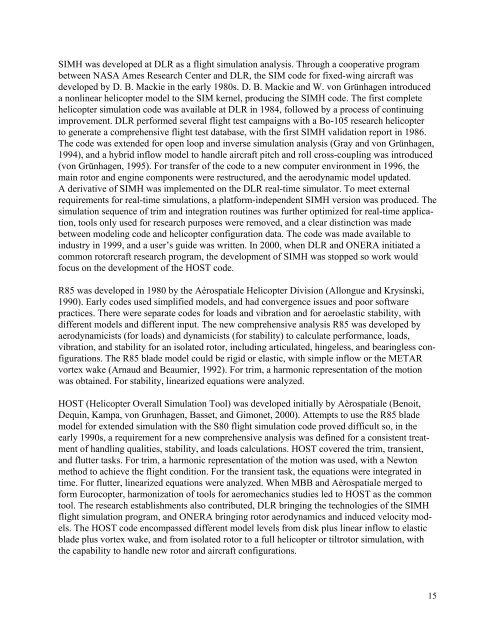A History of Rotorcraft Comprehensive Analyses
A History of Rotorcraft Comprehensive Analyses
A History of Rotorcraft Comprehensive Analyses
Create successful ePaper yourself
Turn your PDF publications into a flip-book with our unique Google optimized e-Paper software.
SIMH was developed at DLR as a flight simulation analysis. Through a cooperative program<br />
between NASA Ames Research Center and DLR, the SIM code for fixed-wing aircraft was<br />
developed by D. B. Mackie in the early 1980s. D. B. Mackie and W. von Grünhagen introduced<br />
a nonlinear helicopter model to the SIM kernel, producing the SIMH code. The first complete<br />
helicopter simulation code was available at DLR in 1984, followed by a process <strong>of</strong> continuing<br />
improvement. DLR performed several flight test campaigns with a Bo-105 research helicopter<br />
to generate a comprehensive flight test database, with the first SIMH validation report in 1986.<br />
The code was extended for open loop and inverse simulation analysis (Gray and von Grünhagen,<br />
1994), and a hybrid inflow model to handle aircraft pitch and roll cross-coupling was introduced<br />
(von Grünhagen, 1995). For transfer <strong>of</strong> the code to a new computer environment in 1996, the<br />
main rotor and engine components were restructured, and the aerodynamic model updated.<br />
A derivative <strong>of</strong> SIMH was implemented on the DLR real-time simulator. To meet external<br />
requirements for real-time simulations, a platform-independent SIMH version was produced. The<br />
simulation sequence <strong>of</strong> trim and integration routines was further optimized for real-time application,<br />
tools only used for research purposes were removed, and a clear distinction was made<br />
between modeling code and helicopter configuration data. The code was made available to<br />
industry in 1999, and a user s guide was written. In 2000, when DLR and ONERA initiated a<br />
common rotorcraft research program, the development <strong>of</strong> SIMH was stopped so work would<br />
focus on the development <strong>of</strong> the HOST code.<br />
R85 was developed in 1980 by the Aèrospatiale Helicopter Division (Allongue and Krysinski,<br />
1990). Early codes used simplified models, and had convergence issues and poor s<strong>of</strong>tware<br />
practices. There were separate codes for loads and vibration and for aeroelastic stability, with<br />
different models and different input. The new comprehensive analysis R85 was developed by<br />
aerodynamicists (for loads) and dynamicists (for stability) to calculate performance, loads,<br />
vibration, and stability for an isolated rotor, including articulated, hingeless, and bearingless configurations.<br />
The R85 blade model could be rigid or elastic, with simple inflow or the METAR<br />
vortex wake (Arnaud and Beaumier, 1992). For trim, a harmonic representation <strong>of</strong> the motion<br />
was obtained. For stability, linearized equations were analyzed.<br />
HOST (Helicopter Overall Simulation Tool) was developed initially by Aèrospatiale (Benoit,<br />
Dequin, Kampa, von Grunhagen, Basset, and Gimonet, 2000). Attempts to use the R85 blade<br />
model for extended simulation with the S80 flight simulation code proved difficult so, in the<br />
early 1990s, a requirement for a new comprehensive analysis was defined for a consistent treatment<br />
<strong>of</strong> handling qualities, stability, and loads calculations. HOST covered the trim, transient,<br />
and flutter tasks. For trim, a harmonic representation <strong>of</strong> the motion was used, with a Newton<br />
method to achieve the flight condition. For the transient task, the equations were integrated in<br />
time. For flutter, linearized equations were analyzed. When MBB and Aèrospatiale merged to<br />
form Eurocopter, harmonization <strong>of</strong> tools for aeromechanics studies led to HOST as the common<br />
tool. The research establishments also contributed, DLR bringing the technologies <strong>of</strong> the SIMH<br />
flight simulation program, and ONERA bringing rotor aerodynamics and induced velocity models.<br />
The HOST code encompassed different model levels from disk plus linear inflow to elastic<br />
blade plus vortex wake, and from isolated rotor to a full helicopter or tiltrotor simulation, with<br />
the capability to handle new rotor and aircraft configurations.<br />
15
















